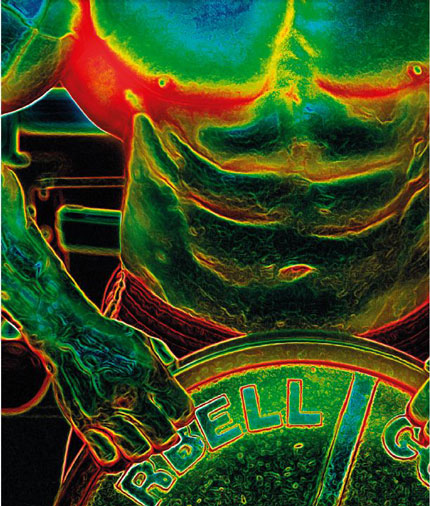Fueling The Anabolic Furnace

I think one of the most common questions I’m asked by clients is, “How much protein should I eat?” This is followed closely by, “How many carbs should I be eating?” These are important questions, don’t get me wrong, but what I wish more people understood is the importance of timing. Properly timing your nutrient intake around your workout can make a sizable impact on your gains. Exercise causes acute changes in the metabolic environment of muscle tissue. First, there’s a significant increase in blood flow to working muscles. There’s also a sharp increase in catecholamines (e.g., noradrenalin, adrenalin). These changes favour catabolism during exercise and allow anabolism immediately afterwards. Because these changes are acute, some lasting only a few hours, the pre- and post-workout meals are critical to optimizing the anabolic effect of exercise.
WINDOW OF OPPORTUNITY
Pre-workout nutritional strategies are based on providing carbs to preserve energy stores and reduce protein breakdown, as well as taking advantage of increased blood flow and enhanced amino acid delivery to muscle tissue. High-intensity exercise places great demands on muscle glycogen stores. Glycogen is the storage form of sugar in your muscles. Because high-intensity exercise burns energy so rapidly, the body is unable to supply sufficient oxygen to enable the use of much fat for fuel. With little oxygen, it must use sugar for fuel. Muscle has two sources of sugar: stored glycogen and the sugar floating around in the bloodstream.
Consuming simple sugars right before training can reduce the amount of glycogen broken down during your workout. This may allow you to train a little longer, but more importantly, higher blood sugar and insulin levels appear to create an environment more favourable for growth. During exercise, high energy demands increase breakdown of not only glycogen but also protein. The body will use amino acids for fuel if other sources of energy are limited. Protein breakdown may also be necessary to provide amino acids for muscle repair after training. This ensures that some degree of adaptation can occur, regardless of the availability of dietary protein. Over time, however, if this process isn’t balanced with additional dietary protein, the net effect will be only maintenance or even a decrease in muscle mass, as many have experienced during periods of prolonged dieting. Taking some simple carbs during your workout can significantly reduce these catabolic effects (Tarpeuning, 1998). The net proteinsparing effect of using a carb drink during your workout is more rapid gains in size and strength.
AMINO ACIDS
Another pre-workout strategy involves taking advantage of increased blood fl ow to working muscles. Because the availability of amino acids is often the limiting factor for protein synthesis, a pre-workout protein meal will enhance the delivery of amino acids to muscle tissue. Research has demonstrated the effectiveness of a pre-workout mixture of essential amino acids (EAAs) and simple carbs. Delivery of amino acids has been shown to be signifi cantly greater during the exercise bout when consumed before working out than when consumed afterward (Tipton, 2001). There’s also a signifi cant difference in amino acid delivery in the fi rst hour after exercise, with the pre-workout amino acid drink providing a significant advantage. Amino acid uptake into the muscle is twice as high with a pre-workout amino acid drink than with a post workout drink. Protein synthesis from blood amino acids is signifi cantly higher when amino acids are taken beforehand. The response of net muscle protein synthesis to consumption of an EAA and carb solution immediately before resistance exercise is greater than when the solution is consumed after exercise, primarily because of increased delivery of amino acids to the working muscle.
But will a protein drink work? Recent research done by the same group of investigators that demonstrated the effectiveness of pre-workout EAAs explored the possibility of using whey protein instead as a pre-workout drink. They found that drinking whey protein immediately before training didn’t produce the same elevated amino acid levels during the workout as drinking straight amino acids (Tipton, 2007). This may seem counterintuitive at first, but when we consider earlier research on the time it takes for whey protein to be digested and absorbed from the gastrointestinal tract, the results aren’t so surprising. Earlier work showed that it takes about one hour for amino acids to peak in the bloodstream (Boirie, 1997). The data shows that the rapidly absorbed EAA solution was able to increase blood amino acid levels about 100 percent during the workout whereas the slower digesting whey protein only increased blood amino acid levels by approximately 30 percent before the workout had ended (Tipton, 2007). This suggests that taking whey protein earlier before training may result in the same effects as the EAAs. This is great news for us lifters on a budget!
AFTER
During exercise, muscles use fuels at an accelerated rate. In order for physical work to be continuous, the body mobilizes stored fuels to make fatty acids, glucose, and amino acids available to burn. This is a catabolic process and cannot occur simultaneously with anabolic processes such as protein synthesis.
For the body to recover from exercise, the catabolic environment must be quickly changed to an anabolic environment. The food that you eat after training is critical to reverse the metabolic state of the body from burn to build. With the rapid introduction of carbohydrate and protein into the system after exercise, the body is able to begin repairing damaged tissue and replenishing fuel reserves.
CARBOHYDRATES
Carbohydrates are important for fueling long workouts but perhaps more important for post-workout glycogen replenishment. Immediately following a workout, your muscles have an increased ability to absorb blood sugar (Goodyear, 1998). This is because of what is called “non-insulin-dependent glucose uptake.”
Normally, muscle cells take up glucose in response to the hormone insulin. Muscle contractions, much like insulin, also cause muscle cells to take up blood glucose (Sherman, 1996). This greatly increases the rate at which glycogen can be replenished after a workout. The effect of exercise on glucose uptake lasts a few hours.
If the post-workout meal is low in carbs, the replenishment of glycogen is delayed. If carbohydrates are lacking in the diet as a whole, over time glycogen stores will continue to fall without being replenished to pre-workout levels.

There has been some controversy about which type of carbohydrate is best after working out. Some argue that simple sugars such as dextrose are best. Others say that drinks with glucose polymers are best. Still others say that there’s no need to buy fancy sports drinks and that simply eating a meal high in carbohydrates such as pasta or rice is sufficient. Studies have shown no difference between different types of carbohydrates eaten after exercise and the rate of glycogen replenishment as long as sufficient quantities of carbohydrate are consumed (Burke, 1997). Even when the post-workout meal contains other foods such as proteins and fats, the rate of glycogen replenishment is the same. These studies tell us that the ratelimiting step in glycogen replenishment after exercise isn’t in digestion or the glycemic index of a given source of carbohydrate. Over a 24-hour period, it’s the total amount of carbohydrate consumed that’s important.
The amount of carbs you need after a workout depends on how long and how hard you worked out. If you just spent a gruelling two hours in the gym, you should try to get about one gram of carbs for every half pound of body weight. So if you weigh 185 pounds, you’ll need about 90 to 95 grams of carbs right after your workout, preferably in liquid form. It’s recommended that you take in that much more about 1.2 hours later as well.
If you experience gastric upset, try diluting your drink or consuming
more water with your carbs. Try to shoot for a total of 15 to 20 grams of carbohydrate per pound of body weight over a 24-hour period for maximum glycogen storage.
This may well be in excess of caloric needs but it’s important to shoot for this intake if glycogen storage is your primary goal.
PROTEIN
In addition to pre-workout consumption, protein is critical after a workout. Protein provides amino acids that are used to rebuild damaged tissues as well as providing enzymes and carrier proteins necessary for adaptation to exercise. Without protein, the body’s ability to adapt to exercise is significantly compromised.
To maximize your gains after working out, you want to maintain a steady flow of amino acids to the muscle. Current recommendations for total protein intake for athletes are between 1.6 and 1.8 grams per kilogram of body weight; however, it isn’t uncommon for bodybuilders to consume in excess of two grams per kilogram of body weight with no ill effects. It should be remembered that the body doesn’t have the capacity to effectively store amino acids, so protein should be eaten at least every three to four hours. The evening meal should contain slow-digesting protein that will allow a steady release of amino acids into your system well into the night. Dinner is a perfect time for steak. Come to think of it, is there any time that isn’t perfect for steak? I think not.

FLUIDS
I couldn’t really write an article about pre- and post-exercise nutrition without at least mentioning fluid replacement. Hydration is extremely important on the cellular level. Muscle growth is inhibited by dehydration. In bodybuilding, we tend not to focus on fluid replacement because, unlike runners or cyclists, most bodybuilders do not become dehydrated after a single workout.
The rate at which you become dehydrated from training depends on how much you sweat (Gisolfi, 1990). Some people sweat a lot when lifting, and others don’t sweat a drop. A good rule of thumb is to drink one millilitre for every calorie that you need. So, if you eat 3,500 calories a day, try to drink three litres. If you exercise in hot or humid climates, add two cups of water for every pound you lose while exercising. As a rule of thumb, the water that you use to mix protein drinks doesn’t count toward meeting your daily water requirements.
IN SUMMARY
There’s no question; the fastest results from all your hard work in the gym can only be realized with smart pre- and postworkout nutrition (Cribb, 2006). The preworkout meal should be high in a quickly digestible protein such as whey or free form amino acids. If using whey, consume your drink 30 to 45 minutes before you train. If taking essential amino acids, take them immediately before working out. This will ensure high blood amino acid levels and enhanced delivery of amino acids to the muscle tissue. Carbohydrates can also be taken in to minimize glycogen loss and suppress catabolic hormones. Glucose polymers work best here. Fat should be avoided before a workout unless the exercise is for endurance.
The post-exercise meal should consist of carbohydrate and protein in an easily and quickly digestible form. There are many meal-replacement products that fit the bill. There’s no need to avoid high-sugar Formulas because right after a workout, fat storage isn’t a big issue. A liquid meal is the most practical method of postworkout feeding, but it should be followed with a solid meal within two hours after exercise.

I can’t in good conscience finish without briefly mentioning the importance of a well-planned diet to go along with your pre- and post-workout meals. Make sure that your daily calories are high enough to support muscle gain. Then make sure that your food choices are supplying a sufficient quantity of protein. Remember, high-quality protein sources such as lowfat dairy, lean meats and poultry, and fish should be your first choices. Then be sure to include good sources of essential fatty acids such as fish oil, flax, and walnuts or pecans. Next, include a wide variety of nutrient-dense fruits and vegetables such as melons, berries, broccoli, and spinach. The remaining calories should come from complex carbs such as brown rice, oats, and other whole-grain foods.
When implemented properly and consistently, strategic pre- and post-workout supplementation can greatly increase the effectiveness of your training. Without optimal nutritional strategies, the body’s response to training can only be considered a compromise at best.

